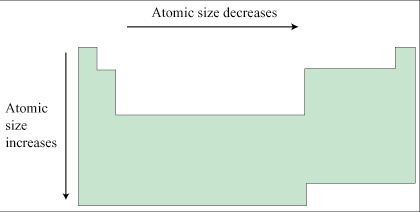Periodic Trends
Periodic trends are specific patterns that are present in the periodic table, which illustrate different aspects of a certain element, including its size and its properties with electrons. The main periodic trends include: electronegativity, ionization energy, electron affinity, atomic radius,melting point, and metallic character. The periodic trends that arise from the arrangement of the periodic table provide chemists with an invaluable tool to quickly predict an element's properties. These trends exist because of the similar atomic structure of the elements within their respective group families or period and the periodic nature of the elements.
- 1. Periodic Trends for Electronegativity
- 2. Periodic Trends for Ionization Energy
- 3. Periodic Trends for Electron Affinity
- 4. Periodic Trends for Atomic Radius
- 5. Periodic Trends for Melting Point
- 6. Periodic Trends for Metallic Character
- 7. Outside Links
- 8. Problems
- 9. Solutions
- 10. References
- 11. Contributors
Periodic Trends for Electronegativity
Electronegativity can be understood as chemical property describing an atom's ability to attract and bind to electrons. Because electronegativity is a qualitative property, there is not a standardized method for calculating electronegativity. However, the scale that most chemists use in quantifying electronegativity is the Pauling Scale, named after the chemist Linus Pauling. The numbers assigned by the Pauling scale are dimensionless due to electronegativity being largely qualitative. Electronegativity values for each element can be found on certain periodic tables. An example is provided below.

Figure 1. Periodic Table of Electronegativity values
Electronegativity measures an atom's strength to attract and form bonds with electrons. This property exists due to the electronic configuration of atoms. Most atoms prefer to fulfilling the octet rule (having the valence, or outer, shell comprise of 8 electrons). Since elements on the left side of the periodic table have less than a half-full valence shell, the energy required to gain electrons is significantly higher compared to the energy required to lose electrons. As a result, the elements on the left side of the periodic table generally lose electrons in forming bonds. Conversely, elements on the right side of the periodic table are more energy-efficient in gaining electrons to create a complete valence shell of 8 electrons. This effectively describes the nature of electronegativity: the more inclined an atom is to gain electrons, the more likely that atom will pull electrons toward itself.
- As you move to the right across a period of elements, electronegativity increases. When the valence shell of an atom is less than half full, it requires less energy to lose an electron than gain one and thus, it is easier to lose an electron. Conversely, when the valence shell is more than half full, it is easier to pull an electron into the valence shell than to donate one.
- As you move down a group, electronegativity decreases. This is because the atomic number increases down a group and thus there is an increased distance between the valence electrons and nucleus, or a greater atomic radius.
- Important exceptions of the above rules include the noble gases, lanthanides, and actinides. The noble gases possess a complete valence shell and do not usually attract electrons. The lanthanides and actinides possess a more complicated chemistry that does not generally follow any trends. Therefore, noble gases, lanthanides, and actinides do not have electronegativity values.
- As for the transition metals, while they have values, there is little variance among them as you move across the period and up and down a group. This is because of their metallic properties that affect their ability to attract electrons as easily as the other elements.
With these two general trends in mind, we can deduce that the most electronegative element is fluorine, which weighs in at a hefty 3.98 Pauling units.

Figure 2. Periodic Table showing Electronegativity Trend
Periodic Trends for Ionization Energy
Ionization Energy is the amount of energy required to remove an electron from a neutral atom in its gaseous phase. Conceptually, ionization energy is considered the opposite of electronegativity. The lower this energy is, the more readily the atom becomes a cation. Therefore, the higher this energy is, the more unlikely the atom becomes a cation. Generally, elements on the right side of the periodic table have a higher ionization energy because their valence shell is nearly filled. Elements on the left side of the periodic table have low ionization energies because of their willingness to lose electrons and become cations. Thus, ionization energy increases from left to right on the periodic table.
Another factor that affects ionization energy is electron shielding. Electron shielding describes the ability of an atom's inner electrons to shield its positively-charged nucleus from its valence electrons. When moving to the right on a period of elements, the number of electrons increases and the strength of shielding increases. As a result, it is easier for valence shell electrons to ionize and thus the ionization energy decreases when going down a group. In certain texts, electron shielding may also be known as screening.
- The ionization energy of the elements within a period generally increases from left to right. This is due to valence shell stability.
- The ionization energy of the elements within a group generally decreases from top to bottom. This is due to electron shielding.
- The noble gases possess very high ionization energies because of their full valence shell as indicated in the graph. Note that Helium has the highest ionization energy of all the elements.

Figure 3. Graph showing the Ionization Energy of the Elements from Hydrogen to Argon
Some elements can have several ionization energies, so we refer to these varying energies as the first ionization energy, the second ionization energy, third ionization energy, etc. The first ionization energy is to the energy needed to remove the outermost, or highest, energy electron and the second ionization energy is the energy required to remove any subsequent high-energy electron from a gaseous cation. Below are the formulas for calculating the first and second ionization energies.
First Ionization Energy:

Second Ionization Energy:

Generally, any subsequent ionization energies (2nd, 3rd, etc.) follow the same periodic trend as the first ionization energy.

Figure 4. Periodic Table Showing Ionization Energy Trend
Ionization energies decrease as atomic radii increase. This observation is affected by n (the principle quantum number) and Zeff (based on the atomic number and shows how many protons are seen in the atom) on the ionization energy (I). Given by the following equation:

- Going across a period, the Zeff increases and n (principal quantum number) remains the same, so that the ionization energy increases.
- Going down a group, the n increases and Zeff increases slightly, the ionization energy decreases.
Periodic Trends for Electron Affinity
Like the name suggests, electron affinity describes the ability of an atom to accept an electron. Unlike electronegativity, electron affinity is a quantitative measure that measures the energy change that occurs when an electron is added to a neutral gas atom. When measuring electron affinity, the more negative the value, the more of an affinity to electrons that atom has.
Electron affinity generally decreases down a group of elements because each atom is larger than the atom above it (this is the atomic radius trend, which will be discussed later in this text). This means that an added electron is further away from the atom's nucleus compared to its position in the smaller atom. With a larger distance between the negatively-charged electron and the positively-charged nucleus, the force of attraction is relatively weaker. Therefore, electron affinity decreases. Moving from left to right across a period, atoms become smaller as the forces of attraction become stronger. This causes the electron to move closer to the nucleus, thus increasing the electron affinity from left to right across a period.
- Electron affinity increases from left to right within a period. This is caused by the decrease in atomic radius.
- Electron affinity decreases from top to bottom within a group. This is caused by the increase in atomic radius.

Figure 5. Periodic Table showing Electron Affinity Trend
Periodic Trends for Atomic Radius
For atoms, the atomic radius is one-half the distance between the nuclei of two atoms is (just like a radius is half the diameter of a circle). However, this idea is complicated by the fact that not all atoms are normally bound together in the same way. Some are bound by covalent bonds in molecules, some are attracted to each other in ionic crystals, and others are held in metallic crystals. Nevertheless, it is possible for a vast majority of elements to form covalent molecules in which two like atoms are held together by a single covalent bond. The covalent radius of these molecules is often referred to as the atomic radius. This distance is measured in picometers. Going through each of the elements of the periodic table, patterns of the atomic radius can be seen.
Atomic size gradually decreases from left to right across a period of elements. This is because, within a period or family of elements, all electrons are being added to the same shell. But, at the same time, protons are being added to the nucleus, making it more positively charged. The effect of increasing proton number is greater than that of the increasing electron number; therefore, there is a greater nuclear attraction. This means that the nucleus attracts the electrons more strongly, having the atom's shell pulled closer to the nucleus. The valence electrons are held closer towards the nucleus of the atom. As a result, the atomic radius decreases.
Going down a group, it can be seen that atomic radius increases. The valence electrons occupy higher levels due to the increasing quantum number (n). As a result, the valence electrons are further away from the nucleus as the ‘n’ increases. Electron shielding prevents these outer electrons from being attracted to the nucleus; thus, they are loosely held and the resulting atomic radius is large.
- Atomic radius decreases from left to right within a period. This is caused by the increase in the number of protons and electrons across a period. One proton has a greater effect than one electron; thus, a lot of electrons will get pulled towards the nucleus, resulting in a smaller radius.
- Atomic radius increases from top to bottom within a group. This is caused by electron shielding.

Figure 6. Periodic Table showing Atomic Radius Trend
Periodic Trends for Melting Point
Melting points are the amount of energy required to break a bond(s) to change the solid phase of a substance to a liquid. Generally, the stronger the bond between the atoms of an element, the higher the energy requirement in breaking that bond. Since temperature is directly proportional to energy, a high bond dissociation energy correlates to a high temperature. Melting points are varied and don't generally form a distinguishable trend across the periodic table. However, certain conclusions can be drawn from the following graph.
- Metals generally possess a high melting point.
- Most non-metals possess low melting points.
- The non-metal carbon possesses the highest boiling point of all the elements. The semi-metal boron also possesses a high melting point.

Figure 7. Chart of Melting Points of Various Elements
Periodic Trends for Metallic Character
The metallic character of an element can be defined as how readily an atom can lose an electron. As you move from right to left across a period, metallic character increases because the attraction between valence electron and the nucleus is weaker, thus enabling an easier loss of electrons. Metallic character increases as you move down a group because the atomic size is increasing. When the atomic size increases, the outer shells are farther away. The principle quantum number increases and average electron density moves farther from nucleus. The electrons of the valence shell have less of an attraction to the nucleus and, as a result, can lose electrons more readily, causing an increase in metallic character.
- Metallic characteristics decrease from left to right across a period. This is caused by the decrease in radius (above it is stated that Zeff causes this) of the atom which allows the outer electrons to ionize more readily.
- Metallic characteristics increase down a group. Electron shielding causes the atomic radius to increase thus the outer electrons ionizes more readily than electrons in smaller atoms.
- Metallic character relates to the ability to lose electrons, and nonmetallic character relates to the ability to gain electrons.
- Another easier way to remember the trend of metallic character is that as you move from left and down towards the bottom-left corner of the periodic table, metallic character increases because you are heading towards Groups 1 and 2, or the Alkali and Alkaline metal groups. Likewise, if you move up and to the right to the upper-right corner of the periodic table, metallic character decreases because you are passing by to the right side of the staircase, which indicate the nonmetals. These include the Group 8, the noble gases, and other common gases such as oxygen and nitrogen.
- In other words:
- Move left across period and down the group: increase metallic character (heading towards alkali and alkaline metals)
- Move right across period and up the group: decrease metallic character (heading towards nonmetals like noble gases)

Figure 8. Periodic Table of Metallic Character Trend
Periodic Trends
In the SparkNote on the Periodic table we discussed a number of simple periodic trends. In this section we will discuss a number of more complex trends, the understanding of which relies on knowledge of atomic structure.
Before getting into these trends, we should engage a quick review and establish some terminology. As seen in the previous section on the octet rule, atoms tend to lose or gain electrons in order to attain a full valence shell and the stability a full valence shell imparts. Because electrons are negatively charged, an atom becomes positively or negatively charged as it loses or gains an electron, respectively. Any atom or group of atoms with a net charge (whether positive or negative) is called an ion. A positively charged ion is a cation while a negatively charged ion is an anion.
Now we are ready to discuss the periodic trends of atomic size, ionization energy, electron affinity, and electronnegativity.
Atomic Size (Atomic Radius)
The atomic size of an atom, also called the atomic radius, refers to the distance between an atom's nucleus and its valence electrons. Remember, the closer an electron is to the nucleus, the lower its energy and the more tightly it is held.
Moving Across a Period
Moving from left to right across a period, the atomic radius decreases. The nucleus of the atom gains protons moving from left to right, increasing the positive charge of the nucleus and increasing the attractive force of the nucleus upon the electrons. True, electrons are also added as the elements move from left to right across a period, but these electrons reside in the same energy shell and do not offer increased shielding.
Moving Down a Group
The atomic radius increases moving down a group. Once again protons are added moving down a group, but so are new energy shells of electrons. The new energy shells provide shielding, allowing the valence electrons to experience only a minimal amount of the protons' positive charge.
Cations and Anions
Cations and anions do not actually represent a periodic trend in terms of atomic radius, but they do affect atomic radius, and so we will discuss them here.
A cation is positively charged, meaning that it is an atom that has lost an electron or electrons. The positive charge of the nucleus is thus distributed over a smaller number of electrons and electron-electron repulsion is decreased, meaning that the electrons are held more tightly and the atomic radius is smaller than in the normal neutral atom. Anions, conversely, are negatively charged ions: atoms that have gained electrons. In anions, electron-electron repulsion increases and the positive charge of the nucleus is distributed over a large number of electrons. Anions have a greater atomic radius than the neutral atom from which they derive.

Ionization Energy and Electron Affinity
The process of gaining or losing an electron requires energy. There are two common ways to measure this energy change: ionization energy and electron affinity.
Ionization Energy
The ionization energy is the energy it takes to fully remove an electron from the atom. When several electrons are removed from an atom, the energy that it takes to remove the first electron is called the first ionization energy, the energy it takes to remove the second electron is the second ionization energy, and so on. In general, the second ionization energy is greater than first ionization energy. This is because the first electron removed feels the effect of shielding by the second electron and is therefore less strongly attracted to the nucleus. If a particular ionization energy follows a previous electron loss that emptied a subshell, the next ionization energy will take a rather large leap, rather than follow its normal gently increasing trend. This fact helps to show that just as electrons are more stable when they have a full valence shell, they are also relatively more stable when they at least have a full subshell.
Ionization Energy Across a Period
Ionization energy predictably increases moving across the periodic table from left to right. Just as we described in the case of atomic size, moving from left to right, the number of protons increases. The electrons also increase in number, but without adding new shells or shielding. From left to right, the electrons therefore become more tightly held meaning it takes more energy to pry them loose. This fact gives a physical basis to the octet rule, which states that elements with few valence electrons (those on the left of the periodic table) readily give those electrons up in order to attain a full octet within their inner shells, while those with many valence electrons tend to gain electrons. The electrons on the left tend to lose electrons since their ionization energy is so low (it takes such little energy to remove an electron) while those on the right tend to gain electrons since their nucleus has a powerful positive force and their ionization energy is high. Note that ionization energy does show a sensitivity to the filling of subshells; in moving from group 12 to group 13 for example, after the d shell has been filled, ionization energy actually drops. In general, though, the trend is of increasing ionziation energy from left to right.
Ionization Energy Down a Group
Ionization energy decreases moving down a group for the same reason atomic size increases: electrons add new shells creating extra shielding that supersedes the addition of protons. The atomic radius increases, as does the energy of the valence electrons. This means it takes less energy to remove an electron, which is what ionization energy measures.
Electron Affinity
An atom's electron affinity is the energy change in an atom when that atom gains an electron. The sign of the electron affinity can be confusing. When an atom gains an electron and becomes more stable, its potential energy decreases: upon gaining an electron the atom gives off energy and the electron affinity is negative. When an atom becomes less stable upon gaining an electron, its potential energy increases, which implies that the atom gains energy as it acquires the electron. In such a case, the atom's electron affinity is positive. An atom with a negative electron affinity is far more likely to gain electrons.
Electron Affinities Across a Period
Electron affinities becoming increasingly negative from left to right. Just as in ionization energy, this trend conforms to and helps explain the octet rule. The octet rule states that atoms with close to full valence shells will tend to gain electrons. Such atoms are located on the right of the periodic table and have very negative electron affinities, meaning they give off a great deal of energy upon gaining an electron and become more stable. Be careful, though: the nobel gases, located in the extreme right hand column of the periodic table do not conform to this trend. Noble gases have full valence shells, are very stable, and do not want to add more electrons: noble gas electron affinities are positive. Similarly, atoms with full subshells also have more positive electron affinities (are less attractive of electrons) than the elements around them.
Electron Affinities Down a Group
Electron affinities change little moving down a group, though they do generally become slightly more positive (less attractive toward electrons). The biggest exception to this rule are the third period elements, which often have more negative electron affinities than the corresponding elements in the second period. For this reason, Chlorine, Cl, (group VIIa and period 3) has the most negative electron affinity.
Electron affinity can be positive and negative value
BalasHapusElectron affinity changed slightly move down the group, although generally a bit more positive (less attractive to electrons). Exactly why it is the biggest exception to this rule on the elements of the third period, which often have more negative electron affinity of the elements involved in the second period. For this reason, chlorine, Cl, (group VIIA and period 3) have the most negative electron affinity?
I think because the elements of the group are simple making it easy to capture electrons to form negative ions and stable.
BalasHapusI think it is because the greater the tendency of these elements in the absorbing electrons (the tendency to form negative ions).
BalasHapusI'll try to answer your question, it's probably due to the properties and reactions in period 3 has unique
BalasHapus